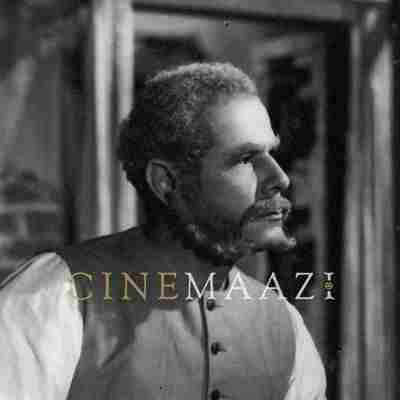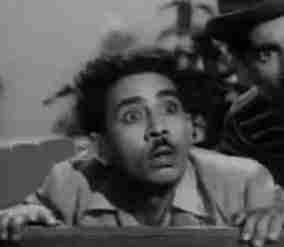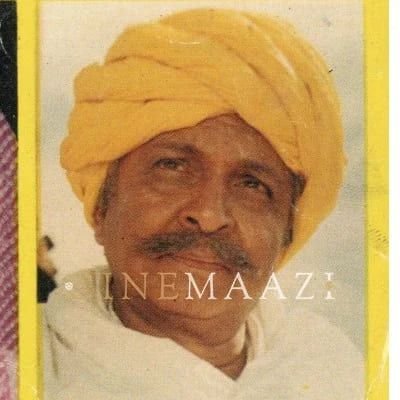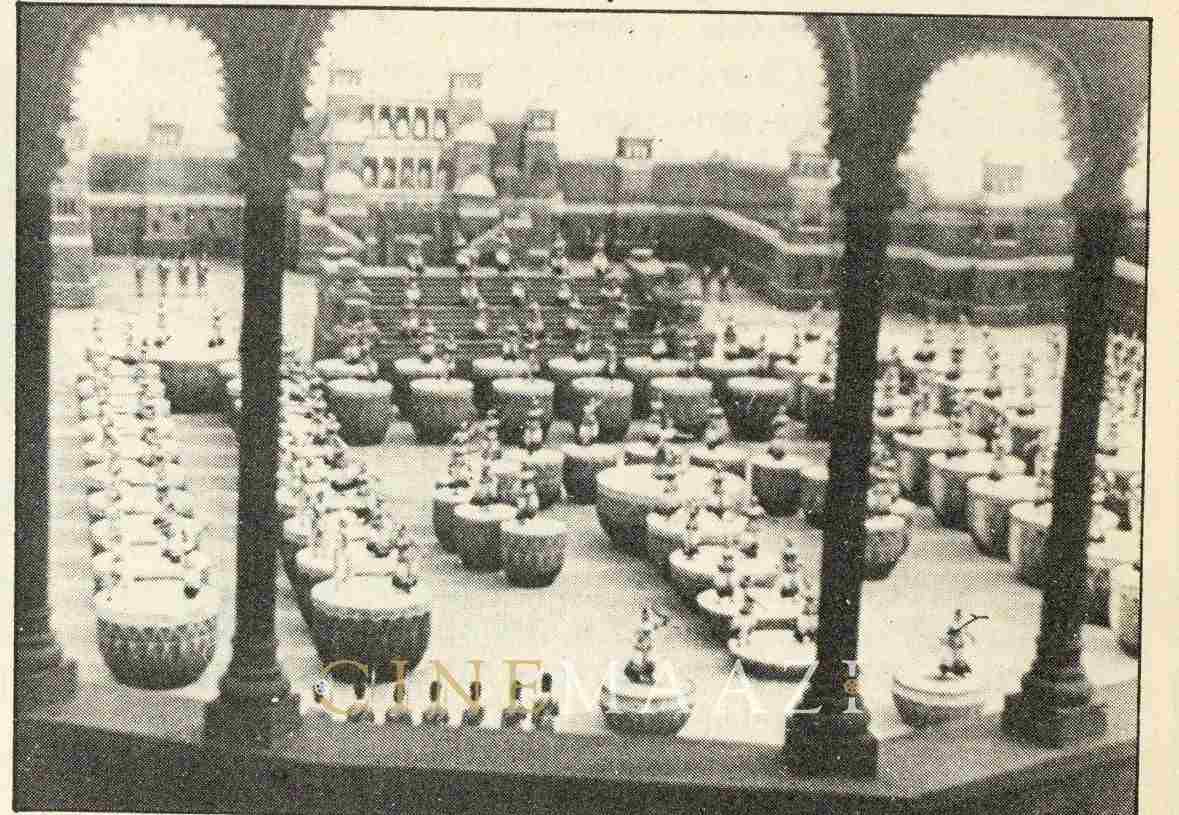Progress of Tamil Cinema
Subscribe to read full article
This section is for paid subscribers only. Our subscription is only $37/- for one full year.
You get unlimited access to all paid section and features on the website with this subscription.
Not ready for a full subscription?
You can access this article for $2, and have it saved to your account for one year.
It was exactly fifty years ago that the first full-length Tamil talkie was screened in Madras. The year was 1931 and the picture 'Kalidas', directed by H.M. Reddi. It was produced by Sagar Movietone of Bombay and featured T.P. Rajalakshmi, the then most popular actress of the Tamil stage.
Technically, though, the first attempt at Tamil sound film was a four-reel-long short film titled 'Korathi Songs and Dances', also produced by Sagar Movietone, and also featuring actress Rajalakshmi. Perhaps, this four-reeler inspired the full length 'Kalidas'.
All the while there were no film studios or production facilities in Madras. Along with their groups of actors, producers trekked to Bombay or Poona or Calcutta to make their films; houses were rented on monthly basis, transport was arranged to carry the artistes to and from the studios - all in strange cities. The studios supplied all the technical personnel - most of them not conversant with the Tamil language.
The one distinct advantage of film-making at Bombay and other Northern centres was that the film could be completed in about three months at an all-inclusive cost of about Rs. 25000 per film. And most, if not all, of these films reaped box office bonanzas.
New Trend
While films in Tamil increased in number, mythology and legend continued as the staple material for films. Songs and stagy dialogue still crowded the film soundtracks and stage actors and actresses continued to hold sway because artistes had to both sing and talk. It was against this background that a new trend - although on a minor scale - set in. For this too, the Tamil stage was largely responsible.
The Tamil stage was, by and large, in the grip of freelancing professionals but there were also a few troupes or 'companies' that staged some dramas that were somewhat off the beaten track. These were plays like 'Dumbachari'. 'Ratnavali', 'Manohara' etc. (these were also later made into films).
So it was that, in the year 1936, the first Tamil social was produced at Bombay, 'Menaka', by Shanmugananda Talkies. This was followed by other 'socials' (or films on contemporary themes) - 'Sathi Leelavathi', 'Chandrakantha', 'Rajambal', 'Rajamani' and many others.
Madras-made
Tamil talkies were turned out from Bombay and Calcutta, till 1934, a landmark year when Srinivas Cinetone Studios produced the first Tamil Talkie in Madras. It was 'Srinivasa Kalyanam'. And within just one year, 35 Tamil talkies had been produced in Madras. A flying start indeed! Production soared steadily from year to year. By the year 1937, there were nine studios in Madras. one at Salem and two at Coimbatore.
Of Saints and Society
While mythology continued to rule as the favourite theme as far as film content was concerned, there were unmistakable signs of better - and different - things to come. In 1935, Vel Pictures, for the first time, produced the biography of a saint - 'Pattinathar'. This was the forerunner of many such films including 'Jothi Ramalinga Swamigal' (1939) about the great saint who preached against the oppressive caste system. 'Nandanar' (1935) and 'Baktha Cheta' (1940) spoke out against untouchability, the curse of Indian society. Here, then, were the beginnings of social messages in the content of the Tamil films. While these were set against an essentially religious and semi-mythological backgorund, reformist ideas were spelt out more directly and with greater impact in some other social films, such as 'Harijana Penn' (1937) and 'Harijana Singam' (1938).
An all important feature of this period was that nationalism began to exert a prominent influence. Till then, the use of songs with nationalistic, patriotic ideas - sometimes covertly, sometimes openly - had been sporadic. Films like 'Pathi Bakthi', 'Valibar Sangam' (1938), 'Ananda Ashram' (1939), 'Desa Bakthi', and others in many and unmistakable ways projected the national aspirations and ideals of the people.
Ms. Tarzan
During this decade, that is, between 1931 and 1941, other genres of film emerged as well; there were 'stunt' movies ('Madras Mail' - 1936: 'Danger Signal' - 1937; 'Punjab Kesari' - 1938 ; 'Bombay Mail' - 1939; 'Santhana Thevan' - 1939) featuring a redeemer, usually masked, of the poor and the oppressed. There were even 'Lady Robin Hoods', robbing the rich to help the poor in films like 'Minnalkodi' (1937) and 'Toofan Queen' (1940). 'Vana Mohini' (1941) featured a lady Tarzan! Times had a indeed changed from when women were reluctant to step onto the screen!
King of Comedy
The unchallenged and unequalled King of Comedy was the great N. S. Krishnan, an institution unto himself. His inclusion in the cast was a box-office guarantee to films in those days. He had his own group of writers, song composers, music directors and artistes and often, he scripted and wrote the songs for his comedy sub-plots, all of whcih he driected himslef. And the comedy was not all - skilfully interwoven with it was a forceful 'social' message; N.S. Krishnan was as much a reformist as he was a comedian.

In 1937, producer Assandas took a unit of actors and technicians overseas to London to film 'Modern Youth', a social talkie. This created a sensation as did his payment of the then fabulous sum of one lakh of rupees to K.B, Sundarambal to play the female lead in 'Nandanar'. These could be said to be the beginnings of sensationalism and publicity build-up, glamour and star values in the Tamil film industry. Notable among the early stars and crowd-pullers was M.K. Thyagaraja Bhagawathar, whose songs were so enchantingly rendered that no sooner were his pictures released, his songs were on the lips of one and all. Films like 'Thiruneelakandar' (1933), 'Ambikapathi' (1937), 'Ashok Kumar' (1941) and 'Sivakavi' (1943) were fantastic box-office hits that steadily raised his star value till his 'Haridas' in 1944 created an all-time record by running for 110 weeks!
Thyagaraja Bhagawathar came from the stage as did P.U. Chinnappa whose pictures like 'Aryamala' (1941) 'Jagathala Prathapan' (1944) and 'Utthama Puthiran' also created box office records. Whereas Thyagaraja Bhagawathar's greatest asset was his voice, actors like P.U. Chinnappa won over audiences both by their songs and more so by their acting talent.
Personalities from the world of classical music also become star attractions : M. S. Subbulakshmi (‘Sakuntala’- 1940 and Baktha Meera’-1945); M. M. Dhanda Nadaswaram played, T. N. Rajarathinam Pillai (Kavi Kalamegam’-1936); Maharajapuram Vishwanatha Iyer (‘Nandanar’); Musiri Subramani Iyer (Tukaram); Papanasam Sivan (‘Baktha Chetha’ ‘Baktha Kuchela’ and ‘Kubera Kuchela’). The stigma attached to performing artists was gradually beginning to fade away and a new social respectability asserted itself.
Further evidence of this was the entry of writers and reputed journalists of the caliber of Elangovan and B.S. Ramayya into the film world. They enriched and elevated the literary content of cinema.
The mid-40s saw many changes in the Tamil film scene. With the advent of playback the ‘talking, singing’ artistes from the stage and the classically-trained musicians were gradually displaced by new entrants with good looking, photogenic faces, and high degree of histrionic talent.
From the legendary and phenomenal M.G. Ramachandran and the gifted Sivaji Ganesan and T. R. Rajakumari, Bhanumathi, Savitri, Padmini, Saroja Devi and K.R. Vijaya, to the present generation of Kamalahasan, Rajnikanth, Sivakumar, Sridevi, Sri Priya, Sujatha And Saritha, there are many numbers of stars who have enriched the Tamil Cinema-and continue to do so.
Darling of the People
Of these, the rise to fame and popularity of M.G. Ramachandaran-or as he is popularly known, M.G.R- is a phenomenon unheard of in the annals of film history in any part of the world. Though he made his film debut in a small role in the year 1936 in Sathi Leelavatji, in 1947 he was first cast as the hero in Jupiter Pictures ‘ Rajakumari’. From then on, through Jupiter’s 'Marmayogi’, Modern Theatres' ‘Ali Baba’ and ‘Forty Thieves’ and Pakshiraja’s ‘Malaikallan’, his was a stupendous ascent from success to success winning for him the titles of ‘Vasool Mannan’ (King of the Box-Office), ‘Makkal Thailakam’ (Darling of the People) and ‘Puratchi Nadigar’ (Revolutionary Actor). To millions of filmgoers, he was the savior of the downtrodden and the champion of the poor. His was no idle talk for the ideals he propagate through his films-as Chief Minister of Tamil Nadu, he could translate them into reality.
The years of the Second World War saw another change which had far reaching consequences. Because of the difficulties in the import of raw stock, the length of feature films was restricted to 11,000 feet. It was a blessing in disguise. ‘Haridas’ for instance, the picture that created an all time box- office record, was one such film.

In 1954, A.V.M. produced ‘Andha Naal’. It was the first picture made in Tamil without a single song or dance and which in spite of these breakaway features, was a box- office success.
Turning Point
The most significant event of this period, however was the entry of C.N. Annadurai- the leader of the Dravida Munnetra Kazhagam (DMK) party - into the film world. Though the first picture written by him was N.S.K. films’ ‘Nallathambi’ (1949), it was Jupiter Pictures’ ‘Velaikkari’ (1949) that was the turning point in the history of Tamil Cinema. It was revolutionary. C.N. Annadurai was an orator of great eloquence and realizing the potential of film as a medium of mass communication, he preached rationalist and reformist ideas to the people, attacking ignorance and blind beliefs with vehemence and vigor. There was an unheard of awakening in the minds of the people. ‘Velaikkari’ was followed by A.V.M.’s ‘Or Iravu’ (One Night) ‘Swargavasal’ and a number of other films, which swept Annadurai and his party, on a wave of mass support, to the seat of power. After Annadurai, the next two Chief Ministers Karunanidhi and MGR are both film world stalwarts.

In 1947, B.N. Reddy founded Vauhini Studio, which was later taken over by B. Nagi Reddy, a man of immense vision, who developed the Studio into the best-planned and best-laid out studio in the whole of the East.
Singular Event
The year 1948 was of momentous importance in the history of Tamil Cinema. A single person and a singular event shook up not only the Tamil film industry but the entire country as well. The person was S.S. Vasan and the event, the release of his spectacular and stupendous ‘Chandralekha’. ‘Chandralekha’, made in Tamil and Hindi, raised the prestige of the Tamil film industry sky high and Vasan followed it up with other films like ‘Mangamma Sabatham’, ‘Dasi Abaranji’, ‘Apoorva Sagotharargal’, ‘Vanji Kottai Valiban' and 'Avvaiyar'. Vasan and ‘Chandralekha’ transformed the entire concept of entertainment in Indian films. His was the first real assault on the Hindi film market and he captured it with a masterly ease. Thus began a series of Hindi films from the South made under the banners of A.V.M., Vauhini, Prasad and Devar.
Vasan also pioneered colour processing in the South by starting the Gemini colour lab in the year 1958. The credit for having made the first full length colour picture in Tamil, however, goes to T.R. Sundrama of Modern Theatres, Salem, who made ‘Ali Baba and Forty Thieves’, featuring M.G.R as the hero, in 1956.
By now, production values, technical excellence and directorial skills played as important a part in the making of films as stars and stories and songs. People began to realize that was more to films than mere talking and singing. Films had indeed come a long way from the early “100% singing, talking, dancing pictures.”
This article is a reproduction of the original published in Fifty Years of Indian Talkies (1931-1981) published by Indian Academy of Motion Picture Arts & Sciences, Bombay.
Tags
About the Author
P Neelakantan was the Principal of the Film Institute in Madras.







.jpg)




